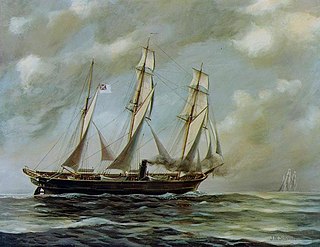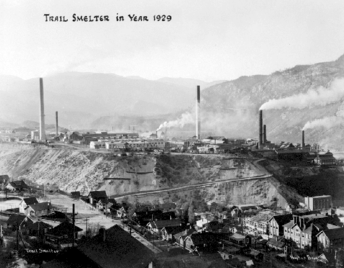
Environmental laws are laws that protect the environment. Environmental law is the collection of laws, regulations, agreements and common law that governs how humans interact with their environment. This includes environmental regulations; laws governing management of natural resources, such as forests, minerals, or fisheries; and related topics such as environmental impact assessments.Environmental law is seen as the body of laws concerned with the protection of living things from the harm that human activity may immediately or eventually cause to them or their species, either directly or to the media and the habits on which they depend.

Northport is a town in Stevens County, Washington, United States. The population was 295 at the 2010 census.

The Alabama Claims were a series of demands for damages sought by the government of the United States from the United Kingdom in 1869, for the attacks upon Union merchant ships by Confederate Navy commerce raiders built in British shipyards during the American Civil War. The claims focused chiefly on the most famous of these raiders, the CSS Alabama, which took more than sixty prizes before she was sunk off the French coast in 1864.

The International Joint Commission is a bi-national organization established by the governments of the United States and Canada under the Boundary Waters Treaty of 1909. Its responsibilities were expanded with the signing of the Great Lakes Water Quality Agreement of 1972. The commission deals with issues affecting the extensive waters and waterways along the Canada–United States border.

Haze is traditionally an atmospheric phenomenon in which dust, smoke, and other dry particulates suspended in air obscure visibility and the clarity of the sky. The World Meteorological Organization manual of codes includes a classification of particulates causing horizontal obscuration into categories of fog, ice fog, steam fog, mist, haze, smoke, volcanic ash, dust, sand, and snow. Sources for particles that cause haze include farming, traffic, industry, windy weather, volcanic activity and wildfires. Seen from afar and depending on the direction of view with respect to the Sun, haze may appear brownish or bluish, while mist tends to be bluish grey instead. Whereas haze often is considered a phenomenon occurring in dry air, mist formation is a phenomenon in saturated, humid air. However, haze particles may act as condensation nuclei that leads to the subsequent vapor condensation and formation of mist droplets; such forms of haze are known as "wet haze".

Franklin D. Roosevelt Lake is the reservoir created in 1941 by the impoundment of the Columbia River by the Grand Coulee Dam in Washington state. It is named for Franklin D. Roosevelt, who was president during the construction of the dam. Covering 125 square miles, it stretches about 150 miles (240 km) from the Canada–US border to Grand Coulee Dam, with over 600 miles (970 km) of shoreline; by surface area it is the largest lake and reservoir in Washington. It is the home of the Lake Roosevelt National Recreation Area.

Teck Resources Limited, known as Teck Cominco until late 2008, is a diversified natural resources company headquartered in Vancouver, British Columbia, that is engaged in mining and mineral development, including coal for the steelmaking industry, copper, zinc, and energy. Secondary products include lead, silver, gold, molybdenum, germanium, indium and cadmium. Teck Resources was formed from the amalgamation of Teck and Cominco in 2001.

An international environmental agreement or sometimes environmental protocol, is a type of treaty binding in international law, allowing them to reach an environmental goal. In other words, it is "an intergovernmental document intended as legally binding with a primary stated purpose of preventing or managing human impacts on natural resources."

Montrose is in the West Kootenay region of southeastern British Columbia. The village lies 7 kilometres (4 mi) east of the city of Trail along Highway 3B.
An arbitration award is a determination on the merits by an arbitration tribunal in an arbitration, and is analogous to a judgment in a court of law. It is referred to as an 'award' even where all of the claimant's claims fail, or the award is of a non-monetary nature.

Arbitration is a form of alternative dispute resolution (ADR) that resolves disputes outside the judiciary courts. The dispute will be decided by one or more persons, which renders the 'arbitration award'. An arbitration decision or award is legally binding on both sides and enforceable in the courts, unless all parties stipulate that the arbitration process and decision are non-binding.

The Prestige oil spill occurred off the coast of Galicia, Spain in November 2002, caused by the sinking of the 26-year-old, structurally deficient oil tanker MV Prestige, carrying 77,000 tonnes of heavy fuel oil. During a storm, it burst a tank on 13 November, and French, Spanish, and Portuguese governments refused to allow the ship to dock. The vessel subsequently sank on 19 November, about 210 kilometres (130 mi) from the coast of Galicia. It is estimated that it spilled 60,000 tonnes or a volume of 67,000 m3 (17.8 million US gal) of heavy fuel oil.

Selwyn Gwillym Blaylock was a part of starting the mining industry in western Canada. He was president of Teck Resources, recipient of several international awards for his work in metallurgy, and was the President of the Canadian Institute of Mining, Metallurgy and Petroleum in 1934–35. For his work he was inducted into the Canadian Mining Hall of Fame.
The Lago Agrio oil field is an oil-rich area near the city of Nueva Loja in the province of Sucumbíos, Ecuador. It is located in the Western Oriente Basin. The site's hydrocarbon-bearing formations are the Cretaceous Napo and Hollin formations. Oil was discovered in the area in 1960s. The Lago Agrio field is known internationally for the serious ecological problems that oil development has created there, including water pollution, soil contamination, deforestation and cultural upheaval. Located in Cofan territory near the Colombian border, it is one of twelve production areas that developed when Ecuador began to export petroleum.

Trail is a city in the West Kootenay region of the Interior of British Columbia, Canada. It was named after the Dewdney Trail, which passed through the area. The town was first called Trail Creek or Trail Creek Landing, and the name was shortened to Trail in 1897.

Justice Jean-Paul Beraudo is a lawyer, academic and author of legal works. He was Justice at the French Supreme Court and vice-chairman of the International Court of Arbitration. He lectures on International Private Law and International Trade Law at Panthéon-Sorbonne University and on Company law at Sciences-Po, Paris. The International Institute for the Unification of Private Law (UNIDROIT) appointed him correspondent for France and a member of the scientific committee.
Investor–state dispute settlement (ISDS) or investment court system (ICS) is a system through which countries can be sued by foreign investors for certain state actions affecting foreign direct investment (FDI). This system most often takes the form of international arbitration between a foreign investor and the nation receiving the FDI.
The Air Quality Agreement is an environmental treaty between Canada and the United States. It was signed on 13 March 1991 by Canadian prime minister Brian Mulroney and American President George H. W. Bush and entered into force immediately. It was popularly referred to during its negotiations as the "Acid Rain Treaty", especially in Canada. Negotiations began in 1986 when Mulroney first discussed the issue with then-president Reagan. Mulroney repeatedly pressed the issue in public meetings with Reagan in 1987 and 1988
The Government of the United States of America and the Government of Canada, hereinafter referred to as "the Parties",
Convinced that transboundary air pollution can cause significant harm to natural resources of vital environmental, cultural and economic importance, and to human health in both countries; Desiring that emissions of air pollutants from sources within their countries not result in significant transboundary air pollution; Convinced that transboundary air pollution can effectively be reduced through cooperative or coordinated action providing for controlling emissions of air pollutants in both countries; Recalling the efforts they have made to control air pollution and the improved air quality that has resulted from such efforts in both countries; Intending to address air-related issues of a global nature, such as climate change and stratospheric ozone depletion, in other fora; Reaffirming Principle 21 of the Stockholm Declaration, which provides that "States have, in accordance with the Charter of the United Nations and the principles of international law, the sovereign right to exploit their own resources pursuant to their own environmental policies, and the responsibility to ensure that activities within their jurisdiction or control do not cause damage to the environment of other States or of areas beyond the limits of national jurisdiction";
Noting their tradition of environmental cooperation as reflected in the Boundary Waters Treaty of 1909, the Trail Smelter Arbitration of 1941, the Great Lakes Water Quality Agreement of 1978, as amended, the Memorandum of Intent Concerning Transboundary Air Pollution of 1980, the 1986 Joint Report of the Special Envoys on Acid Rain, as well as the ECE Convention on Long-Range Transboundary Air Pollution of 1979;
Convinced that a healthy environment is essential to assure the well-being of present and future generations in Canada and the United States, as well as of the global community;
Have agreed as follows: ...
Pakootas v. Teck Cominco Metals is a citizen lawsuit filed under the 1980 Comprehensive Environmental Response, Compensation, and Liability Act (CERCLA) by Joseph A. Pakootas and Donald R. Michel brought to the United States District Court for the Eastern District of Washington against Teck Cominco—, now Teck Resources—which is headquartered in Canada. Pakootas and Michel filed the suit The plaintiffs, Pakootas and Michel, were enrolled members of the Confederated Tribes of the Colville Reservation who, under CERCLA's citizen suit provision filed the suit to enforce the "Unilateral Administrative Order for Remedial Investigation/Feasibility Study (UAO) issued to the defendant by the United States Environmental Protection Agency (EPA).

The Teck Cominco smelter, also known as the Teck Cominco Lead-Zinc Smelter, Cominco Smelter, and Trail smelter located in Trail, British Columbia, Canada, is the largest integrated lead-zinc smelter of its kind in the world. It is situated approximately 10 miles (16 km) north of the border between British Columbia, Canada and Washington, in the United States, on the Columbia River. It is owned and operated by Vancouver, British Columbia-based Teck Cominco Metals Ltd—renamed Teck Resources.














